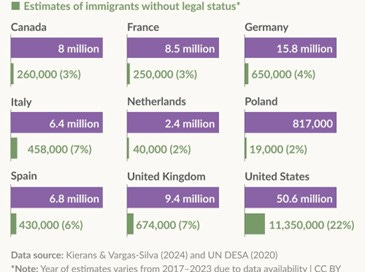[Time for another set of questions and answers, based on a topic that is of global interest.
Meanwhile… the Geography community is growing over on Bluesky. No bots; and a more pleasant discourse than the other place.]
Questions
1. In 2023, how many international migrants did the World Bank say there was in the world?
2. Of this total, how many were classed as refugees? ( A refugee is someone who is forced to leave his/her own country to escape war, persecution or natural disaster, including climate change).
3. Which continent(s) has the highest number of migrants?
4. Which continent had the highest rate of increase in migrants between 2000 and 2020?
5. Another form of migrant is a IDP migrant. What does IDP stand for?
6. Which 10 countries have the most IDP?
7. In 2022, which country is thought to have had 6.5 million refugees moving to other countries, AND, 7 million IDP?
8. Migrants are important sources of remittances for their home country. What are remittances?
9. A number of politicians now refer to ‘illegal' migrants. What does this mean?
10. A new way to classify migrants has been suggested by the World Bank. On the one hand, migrants may have varying skill levels (high to low), and on the other, varying motives (economic opportunity to fear). Can you provide a real-world example of each of these types of migrant:
· High skill, high economic opportunity
· Low skill, high fear
· High skill, high fear
· Low skill, low economic opportunity.
Answers
1. An estimated 280 million, which represents 3.5% of the global population.
2. 37 million. This figure is unreliable as some people are not formally registered as migrants. Such people are said to be undocumented. The USA alone has between 10 and 20 million such people.
3. Both Asia and Europe have 80 million migrants each. Together they account for 2/3rds of the world's migrants.
4. Asia. There was a 75% increase – an extra 37 million in actual numbers.
5. Internally Displaced People. People forced to flee their home to move elsewhere in their own country. The UN estimates there were 62 million IDP in 2023.
6. Afghanistan, Colombia, DRC, Ethiopia, Nigeria, Somalia, Sudan, Syria, Ukraine, Yemen.
7. Ukraine.
8. Financial transfers made by migrants directly to their families or communities in their countries of origin.
9. These people have entered a country in an unofficial way, or have overstayed their visa deadline. For the former, it is often difficult to enter a country when formal channels of entry are not provided, but they are still labelled ‘illegal'. Some other politicians prefer to use the term ‘irregular' migrants.
10.
Indian doctors working in the NHS
Rohingya people living in Bangladesh
Ukraine care workers in UK care homes
Mexican workers picking fruit in California.
Finally, here is an infographic that was published recently by Our World in Data on the topic – the relative proportions of immigrants in selected countries and the proportion of immigrants without ‘legal status’ in those countries. Some people use alternative terms to the latter, such as ‘undocumented migration’, ‘illegal migration’, and ‘irregular migration’. These people are currently subject to much political debate, for example in the USA.




